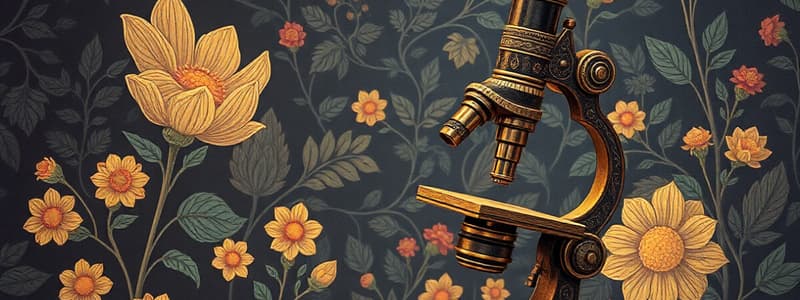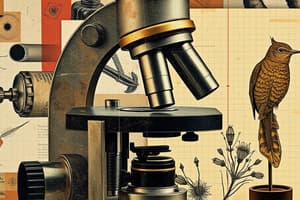Podcast
Questions and Answers
What was a significant contribution made by Lister in the evolution of microscopy?
What was a significant contribution made by Lister in the evolution of microscopy?
- He created a mathematical equation for lens design.
- He introduced the concept of immersion objectives.
- He developed a device using weak lenses to eliminate spherical aberration. (correct)
- He improved the manufacturing process of microscopes.
What was the innovation introduced by Ernst Leitz regarding microscope design?
What was the innovation introduced by Ernst Leitz regarding microscope design?
- The first immersion objective microscope.
- Microscopes with five adjustable lenses on a movable turret. (correct)
- A device that uses digital imaging technology.
- A microscope that operates without any lenses.
Which principle did Ernst Abbe establish that is fundamental to modern computational optics?
Which principle did Ernst Abbe establish that is fundamental to modern computational optics?
- The use of glass in lens construction.
- The mathematical formula known as the 'Abbe Equation'. (correct)
- The fixed lens arrangement for optical clarity.
- The exclusive use of trial and error methods in optics.
What did Abbe develop that improved microscope resolution?
What did Abbe develop that improved microscope resolution?
What does the 'Abbe Equation' calculate?
What does the 'Abbe Equation' calculate?
What is the function of the illuminator in a microscope?
What is the function of the illuminator in a microscope?
How does the diaphragm affect the viewing of a specimen?
How does the diaphragm affect the viewing of a specimen?
What should be adjusted first when preparing to view a specimen under the microscope?
What should be adjusted first when preparing to view a specimen under the microscope?
Where are the condenser lenses located in relation to the stage?
Where are the condenser lenses located in relation to the stage?
Which knob is primarily used for initial focusing with a 10X objective?
Which knob is primarily used for initial focusing with a 10X objective?
Why is the condenser important for high magnification observations?
Why is the condenser important for high magnification observations?
What is primarily controlled by the diaphragm in a microscope?
What is primarily controlled by the diaphragm in a microscope?
What should be done after adjusting the interpupillary distance?
What should be done after adjusting the interpupillary distance?
What is the function of the fine adjustment knob when focusing a microscope?
What is the function of the fine adjustment knob when focusing a microscope?
Why is it important to rotate the knurled ring on the left eyepiece tube with only the left eye?
Why is it important to rotate the knurled ring on the left eyepiece tube with only the left eye?
What does the term 'Parfocality' refer to in microscopy?
What does the term 'Parfocality' refer to in microscopy?
Which feature ensures that a centered particle remains centered when changing objectives?
Which feature ensures that a centered particle remains centered when changing objectives?
What is the primary reason a microscope is essential in a microbiology laboratory?
What is the primary reason a microscope is essential in a microbiology laboratory?
What is the standard magnification power of a compound microscope?
What is the standard magnification power of a compound microscope?
Which component of the microscope allows for the adjustment of the specimen slides?
Which component of the microscope allows for the adjustment of the specimen slides?
What is the primary function of the coarse adjustment knob?
What is the primary function of the coarse adjustment knob?
How many objective lenses are typically found on a compound microscope?
How many objective lenses are typically found on a compound microscope?
What is the role of the eyepiece in a microscope?
What is the role of the eyepiece in a microscope?
What is the primary use of the fine adjustment knob?
What is the primary use of the fine adjustment knob?
Which part of the microscope holds the eyepiece just above the objective lens?
Which part of the microscope holds the eyepiece just above the objective lens?
Which of the following statements about stage clips is true?
Which of the following statements about stage clips is true?
What are the three main tasks that a microscope must accomplish?
What are the three main tasks that a microscope must accomplish?
Which civilization is associated with the earliest known use of glass magnification?
Which civilization is associated with the earliest known use of glass magnification?
Who was the first philosopher to record the effect of glass magnification?
Who was the first philosopher to record the effect of glass magnification?
What were the instruments developed by the Chow-Foo dynasty called?
What were the instruments developed by the Chow-Foo dynasty called?
In which century did Western inventors begin experimenting with lenses?
In which century did Western inventors begin experimenting with lenses?
What did Seneca observe about magnification?
What did Seneca observe about magnification?
When did the term 'microscope' start gaining popularity?
When did the term 'microscope' start gaining popularity?
What advancement in optics occurred in 1284 AD?
What advancement in optics occurred in 1284 AD?
Flashcards are hidden until you start studying
Study Notes
Microscope Components and Functions
- Mechanical Stage: Allows movement of the slide via two knobs (left/right and up/down), facilitating precise specimen positioning.
- Illuminator: Light source located at the base of the microscope, replacing mirrors; typically uses low-voltage light (about 100V).
- Condenser: Lenses that collect and focus light onto the specimen; enhances clarity, especially at high magnifications (400X and above).
- Diaphragm: Controls light intensity and beam size reaching the specimen; adjustable for optimal viewing conditions.
Procedure for Focusing the Microscope
- Initiate by turning on the lamp; adjust light intensity for comfort.
- Adjust binocular tubes to fuse light circles for individual eye accommodation (interpupillary distance).
- Place specimen slide on the stage; use coarse adjustment knob for initial focus with the 10X objective, using the right eye.
- Fine-tune focus using the left eyepiece’s knurled ring without adjusting the main focus knobs.
- Transitioning to higher power objectives requires minimal adjustments due to parfocality (maintaining focus) and parcentricity (keeping the image centered).
History of Microscopy
- Term Origin: Derived from Greek 'mikro' (minute size) and 'skopion' (means of viewing); popularized around 1625.
- Early Discoveries: Glass lenses discovered in ancient civilizations; Nimrud lens (710 BC) from Assyrian culture noted as significant.
- Euclid's Contributions: Recorded the effect of magnification through glass (300 BC) in “Optica”; noted water's effect on enlarging text.
- Advancements in China: Chow-Foo dynasty utilized water-filled tubes (water microscopes) for magnification over 150-fold, 4000 years ago.
Advances in Optics
- Inventors of the 13th Century: Experiments with lenses began; wearable spectacles invented in Italy (1284 AD).
- Ernst Leitz (1800s): Created multi-lens microscopes with adjustable magnifications; contributed to practical microscopy tools.
- Ernst Abbe's Work: In 1866, established mathematical principles for optics, pivotal for modern microscopy design and theory.
- Abbe Equation: A mathematical formula determining maximum resolution of microscopes; standard magnification typically at 10X.
Microscope Parts Explained
- Eyepiece Tube: Holds eyepiece above the objective lens; monocular tubes are rigid while binoculars may rotate for positioning.
- Objective Lenses: Range from 40X to 100X magnification; housed on the nose piece for flexible magnification adjustments.
- Nose Piece: Movable turret that holds objective lenses and allows for rapid switching between magnifications.
- Adjustment Knobs: Coarse adjustment for quick focusing; fine adjustment for precise focusing, particularly at higher magnifications.
- Stage: Platform for slides equipped with clips to hold specimens in place; mechanical stages allow controlled movement.
- Stage Clips: Secure slides for stable viewing; essential for maintaining focus on the specimen.
Importance of Microscopes
- Essential tools in microbiology labs for viewing minute organisms like bacteria and fungi; reveal the otherwise invisible microbial world.
Studying That Suits You
Use AI to generate personalized quizzes and flashcards to suit your learning preferences.




